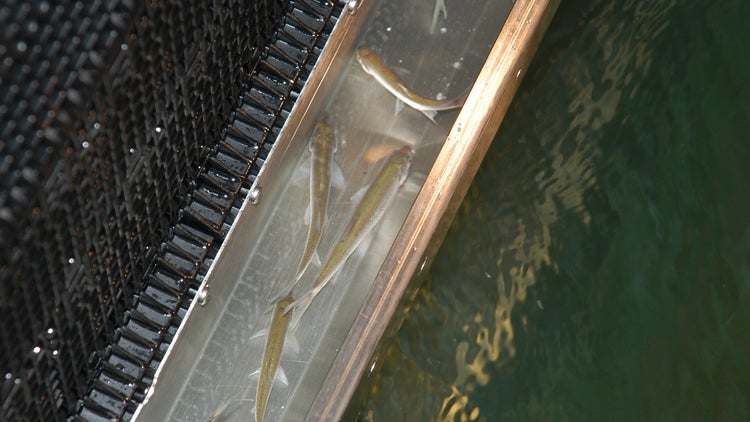Meet or exceed all regulations
Hydrolox screens were designed hand-in-hand with end users, consultants, and government regulators both to satisfy regulatory standards and address the shortcomings of existing screening technology. Thanks to their maintenance-free operation and smooth engineered polymer mesh, our screens have been recognized by government regulators in the U.S. and UK as the best technology available for aquatic life protection—and follow-up studies continue to confirm it.

Environmentally Friendly Features of Hydrolox Screens
- Available in specific mesh sizes (<2 mm) designed to minimize impingement and entrainment
- Cantilevered head section ensures accurate fish delivery
- Patented, sealed boot section prevents aquatic life or debris from passing under the screen and eliminates moving underwater parts
- Proprietary tensioning system eliminates guesswork and maintenance related to screen tension issues
- Smooth, impact- and abrasion-resistant surfaces are fully sealable along the sides, noncorrosive, and easy to clean
The Environmental Protection Agency (EPA)’s Section 316(b) of the Clean Water Act requires that the location, design, construction, and capacity of cooling water intake structures reflect the best technology available (BTA) for minimizing environmental impacts. Our screens not only meet 316(b)’s qualifications for BTA—they’re also specifically mentioned in the regulation itself for having “shown promise in reducing impingement mortality.”
The 2009 Eels Regulations require companies in the UK who utilize water extraction to meet a threshold of 40% eel “escapement.” Independent testing with a well-known research organization in the UK has identified Hydrolox screens as the best technology for fish protection available on the market, and The Environment Agency has identified Hydrolox traveling water screens as a solution for those facilities managing glass eel, elver, and adult yellow/silver eel populations.
A regional directive specific to the U.S. Pacific Northwest, 1997's NOAA NMFS Directive was designed to protect the downstream migration of salmonids after spawning season. In addition to criteria regarding mesh, the directive requires that screens be sized correctly to allow for appropriate approach velocity. The Senior Engineer at NOAA Fisheries confirmed that our smooth surface mesh design with a 1.75-mm opening meets the mesh criteria. When we design your screen, we ensure that its size meets approach velocity requirements.
- Electric Power Research Institute's (EPRI) report, Hydrolox Traveling Water Screen Fish Impingement and Survival Case Study: Plant Barry Generating Station, evaluates the survival of fish exposed to a Hydrolox traveling water screen specifically designed to protect juvenile and adult fish at Alabama Power Company's Plant Barry Generating Station
Further reports are available upon request.
The Hydrolox Series 6000 Intake Screen is certified to NSF/ANSI/CAN 61 Drinking Water System Components - Health Effects by NSF, a leading independent public health and safety organization. To receive certification, we submitted product samples to NSF that underwent rigorous testing to the requirements of NSF/ANSI/CAN 61. Additionally, we agreed to unannounced manufacturing facility audits and periodic retesting to verify continued conformance to the standards.
Official online certification listing